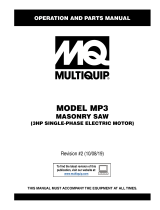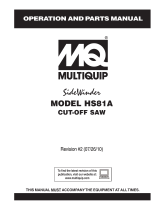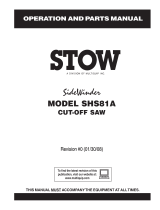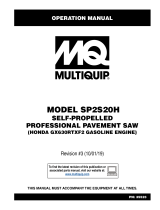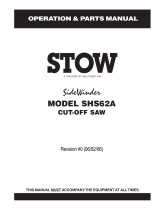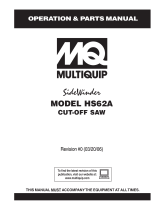Page is loading ...

OPERATION AND PARTS MANUAL
THIS MANUAL MUST ACCOMPANY THE EQUIPMENT AT ALL TIMES.
Revision #3 (10/08/19)
P/N 38261
To find the latest revision of this
publication, visit our website at:
www.multiquip.com
MP1 SERIES
MODELS: MP115E,
MP120E, MP1H
MASONRY SAWS
(1.5 HP 1Ø ELECTRIC MOTOR)
(2.0 HP 1Ø ELECTRIC MOTOR)
(4.8 HP HONDA GASOLINE ENGINE)

PAGE 2 — MP1 SERIES MASONRY SAW • OPERATION AND PARTS MANUAL — REV. #3 (10/08/19)
PROPOSITION 65 WARNING

MP1 SERIES MASONRY SAW • OPERATION AND PARTS MANUAL — REV. #3 (10/08/19) — PAGE 3
Grinding/cutting/drilling of masonry, concrete, metal and
other materials with silica in their composition may give
off dust or mists containing crystalline silica. Silica is a
basic component of sand, quartz, brick clay, granite and
numerous other minerals and rocks. Repeated and/or
substantial inhalation of airborne crystalline silica can
cause serious or fatal respiratory diseases, including
silicosis.In addition, California and some other
authorities have listed respirable crystalline silica as a
substance known to cause cancer. When cutting such
materials, always follow the respiratory precautions
mentioned above.
WARNING
Grinding/cutting/drilling of masonry, concrete, metal and
other materials can generate dust, mists and fumes
containing chemicals known to cause serious or fatal
injury or illness, such as respiratory disease, cancer,
birth defects or other reproductive harm. If you are
unfamiliar with the risks associated with the particular
process and/or material being cut or the composition of
the tool being used, review the material safety data
sheet and/or consult your employer, the material
manufacturer/supplier, governmental agencies such as
OSHA and NIOSH and other sources on hazardous
materials. California and some other authorities, for
instance, have published lists of substances known to
cause cancer, reproductive toxicity,or other harmful
effects.
Control dust, mist and fumes at the source where
possible. In this regard use good work practices and
follow the recommendations of the manufacturers or
suppliers, OSHA/NIOSH, and occupational and trade
associations.Water should be used for dust
suppression when wet cutting is feasible. When the
hazards from inhalation of dust, mists and fumes cannot
be eliminated, the operator and any bystanders should
always wear a respirator approved by NIOSH/MSHA for
the materials being used.
WARNING
SILICOSIS WARNING RESPIRATORY HAZARDS
SILICOSIS/RESPIRATORY WARNINGS

PAGE 4 — MP1 SERIES MASONRY SAW • OPERATION AND PARTS MANUAL — REV. #3 (10/08/19)
TABLE OF CONTENTS
MP1 Masonry Saw
Proposition 65 Warning ........................................... 2
Silicosis/Respiratory Warnings ................................ 3
Table Of Contents .................................................... 4
Safety Information ................................................ 6-9
Specifications ........................................................ 10
Dimensions ............................................................ 11
General Information ............................................... 12
Saw Components ............................................. 14-15
Electric Motor Components ................................... 16
Engine Components .............................................. 17
Set-Up .............................................................. 18-23
Operation .......................................................... 24-27
Maintenance ..................................................... 28-31
Wiring Diagram (Engine) ....................................... 32
Wiring Diagram (Electric Motor) ............................ 33
Troubleshooting (Blade) ......................................... 34
Troubleshooting (Electric Motor) ............................ 35
Troubleshooting (Engine) ....................................... 36
Explanation Of Codes In Remarks Column ........... 38
Suggested Spare Parts ......................................... 39
Component Drawings
Name Plate And Decals ................................... 40-41
Tray Assembly .................................................. 42-43
Cart Assembly .................................................. 44-45
Motor Plate And Shaft Assembly ...................... 46-47
Engine Honda 4.8 HP Assembly ...................... 48-49
Electric Motor Assembly ................................... 50-51
Water Pump Assembly (Gasoline Only) ........... 52-53
Support Stand Assembly (Option) .................... 54-55
HONDA GX160K1QXC9 Drawings
Air Cleaner Assembly ....................................... 56-57
Camshaft Assembly .......................................... 58-59
Carburetor Assembly ........................................ 60-61
Control Assembly ............................................. 62-63
Crankcase Cover Assembly ............................. 64-65
Crankshaft Assembly ........................................ 66-67
Cylinder Barrel Assembly ................................. 68-69
Cylinder Head Assembly .................................. 70-71
Fan Cover Assembly......................................... 72-73
Flywheel Assembly ........................................... 74-75
Fuel Tank Assembly .......................................... 76-77
Ignition Coil Assembly ...................................... 78-79
Muffler Assembly .............................................. 80-81
Piston And Rings Assembly ............................. 82-83
Recoil Starter Assembly ................................... 84-85
Gasket Kit Assembly ........................................ 86-87
Labels Assembly .............................................. 88-89
NOTICE
Specifications are subject to change without notice.

MP1 SERIES MASONRY SAW • OPERATION AND PARTS MANUAL — REV. #3 (10/08/19) — PAGE 5
NOTES

PAGE 6 — MP1 SERIES MASONRY SAW • OPERATION AND PARTS MANUAL — REV. #3 (10/08/19)
SAFETY INFORMATION
Do not operate or service the equipment before reading
the entire manual. Safety precautions should be followed
at all times when operating this equipment.
Failure to read and understand the safety
messages and operating instructions could
result in injury to yourself and others.
SAFETY MESSAGES
The four safety messages shown below will inform you
about potential hazards that could injure you or others. The
safety messages specifi cally address the level of exposure
to the operator and are preceded by one of four words:
DANGER, WARNING, CAUTION
or NOTICE.
SAFETY SYMBOLS
DANGER
Indicates a hazardous situation which, if not avoided,
WILL result in DEATH or SERIOUS INJURY.
WARNING
Indicates a hazardous situation which, if not avoided,
COULD result in DEATH or SERIOUS INJURY.
CAUTION
Indicates a hazardous situation which, if not avoided,
COULD result in MINOR or MODERATE INJURY.
NOTICE
Addresses practices not related to personal injury.
Potential hazards associated with the operation of this
equipment will be referenced with hazard symbols which
may appear throughout this manual in conjunction with
safety messages.
Rotating parts hazards
Symbol Safety Hazard
Cutting and crushing hazards
Electric shock hazards

MP1 SERIES MASONRY SAW • OPERATION AND PARTS MANUAL — REV. #3 (10/08/19) — PAGE 7
SAFETY INFORMATION
GENERAL SAFETY
WARNING
Adherence to the OSHA 2017 Ruling governing
Occupational Exposure to Respirable Crystalline Silica,
requires that all sawing operations MUST BE conducted
with an integrated water delivery system that feeds water
to the blade.
CAUTION
NEVER operate this equipment without proper protective
clothing, shatterproof glasses, respiratory protection,
hearing protection, steel-toed boots and other protective
devices required by the job or city and state regulations.
Avoid wearing jewelry or loose fi tting clothes that may
snag on the controls or moving parts as this can cause
serious injury.
NEVER operate this equipment when not
feeling well due to fatigue, illness or when
under medication.
NEVER operate this equipment under the
infl uence of drugs or alcohol.
ALWAYS clear the work area of any debris, tools, etc.
that would constitute a hazard while the equipment is
in operation.
No one other than the operator is to be in the working
area when the equipment is in operation.
ALWAYS check the equipment for loosened threads or
bolts before starting.
DO NOT use the equipment for any purpose other than
its intended purposes or applications.
NOTICE
This equipment should only be operated by trained and
qualifi ed personnel 18 years of age and older.
Whenever necessary, replace nameplate, operation and
safety decals when they become diffi cult read.
Manufacturer does not assume responsibility for any
accident due to equipment modifi cations. Unauthorized
equipment modifi cation will void all warranties.
NEVER
use accessories or attachments that are not
recommended by Multiquip for this equipment. Damage
to the equipment and/or injury to user may result.
ALWAYS know the location of the nearest
fi re extinguisher.
ALWAYS know the location of the nearest
fi rst aid kit.
ALWAYS know the location of the nearest phone or
keep
a phone on the job site.
Also, know the phone numbers
of the nearest ambulance, doctor and
fi re department.
This information will be invaluable in the case of an
emergency.

PAGE 8 — MP1 SERIES MASONRY SAW • OPERATION AND PARTS MANUAL — REV. #3 (10/08/19)
SAFETY INFORMATION
SAW SAFETY
DANGER
NEVER operate the equipment in an explosive atmosphere
or near combustible materials. An explosion or fi re could
result causing severe bodily harm or even death.
WARNING
Accidental starting can cause severe injury
or death. ALWAYS place the ON/OFF
switch in the OFF position.
Keep hands away from moving parts at all
times.
NEVER disconnect any emergency
or safety devices. These devices are
intended for operator safety. Disconnection of these
devices can cause severe injury, bodily harm or even
death. Disconnection of any of these devices will void
all warranties.
CAUTION
ALWAYS ensure saw is securely placed on appropriate
blocks or jackstands when maintenance requires
elevation of the saw.
If the machine malfunctions, stop the saw immediately
and secure it. Fix the problem as soon as possible.
NOTICE
ALWAYS keep the machine in proper running condition.
Fix damage to machine and replace any broken parts
immediately.
Make sure there is no buildup of grease, oil or debris
on the machine.
ALWAYS store equipment properly when it is not being
used. Equipment should be stored in a clean, dry location
out of the reach of children and unauthorized personnel.
BLADE SAFETY
WARNING
Rotating blade can cut and crush. ALWAYS
keep hands and feet clear while operating
the saw.
CAUTION
NEVER operate the saw without blade
guards and covers in place. Exposure of
the diamond blade must not exceed 180
degrees.
Verify the motor start switch is set to the OFF position
before installing a blade.
ALWAYS inspect blade before each
use. The blade should exhibit no cracks,
dings, or fl aws in the steel centered core
and/or rim. Center (arbor) hole must be
undamaged and true.
NOTICE
Use proper blades and follow blade manufacturer’s
recommendations. Match the blade RPM (blade shaft
RPM) to the recommended blade surface feet per minute
(SFPM).
Ensure the blade-mounting bolt is tightened
adequately
ALWAYS
examine blade flanges for damage and
excessive wear.
Ensure the blade is marked with an operating speed
greater than the spindle speed of the saw.
Only cut the material that is specifi ed for the diamond
blade. Read the specifi cation of the diamond blade to
ensure the proper tool has been matched to the material
being cut.
Ensure that water is used during sawing operations and
that a suffi cient fl ow of water is applied to both sides of
the blade.
DO NOT
drop the diamond blade on ground or surface.
Ensure that the blade is mounted for proper operating
direction.
Adhere to the blade manufacturer’s recommendations
on handling, storage and safe usage of blades.

MP1 SERIES MASONRY SAW • OPERATION AND PARTS MANUAL — REV. #3 (10/08/19) — PAGE 9
SAFETY INFORMATION
ELECTRIC MOTOR SAFETY
NOTICE
Operate electric motor only at the specifi ed voltage
indicated on the nameplate.
DO NOT spray water onto electric motor.
ALWAYS disconnect AC power plug from power source
before moving saw, changing blade, or performing
maintenance.
ALWAYS make sure the ON/OFF switch
on the electric motor is in the OFF position
when not in use and before inserting the
saw’s power plug into an AC receptacle.
Power Cord/Cable Safety
DANGER
NEVER let power cords or cables lay in water.
NEVER use damaged or worn cables or cords when
connecting equipment to generator. Inspect for cuts in
the insulation.
NEVER grab or touch a live power
cord or cable with wet hands. The
possibility exists of electrical shock,
electrocution or death.
Make sure power cables are securely
connected. Incorrect connections may
cause electrical shock and damage to the
saw.
CAUTION
Ensure that cables and cords will not be tripped over or
trapped underneath the saw.
Never use the cable to pull out the plug from the power
source.
NOTICE
ALWAYS make certain that proper power or extension
cord has been selected for the job.
Protect the cable from heat, oil, and sharp edges.
LIFTING SAFETY
CAUTION
NEVER
allow any person or animal to stand underneath
the equipment while lifting.
Some saws are very heavy and awkward to move around.
Use proper heavy lifting procedures.
DO NOT lift machine to unnecessary heights.
NEVER lift the equipment while the motor is running.
TRANSPORTING SAFETY
NOTICE
ALWAYS shutdown motor before transporting.
ALWAYS
tie down equipment during transport by
securing the equipment with rope.
Ensure that the diamond blade does not come into contact
with the ground or surface during transportation.
NEVER
transport the saw to or from the job site with the
blade mounted.
ENVIRONMENTAL SAFETY
NOTICE
Dispose of hazardous waste properly.
Examples of potentially hazardous waste
are used motor oil, fuel and fuel fi lters.
DO NOT
use food or plastic containers to dispose of
hazardous waste.
DO NOT
pour waste, oil or fuel directly onto the ground,
down a drain or into any water source.

PAGE 10 — MP1 SERIES MASONRY SAW • OPERATION AND PARTS MANUAL — REV. #3 (10/08/19)
SPECIFICATIONS
Table 1. Saw Specifications
Dimensions
43.75" x 33" x 27" (111.125 cm x 83.82 cm x 68.58 cm)
Approximate Weight
165 lbs. (75 Kg.)
Electric
Motor Speed
3450 RPM (See Table 2)
Blade Shaft Speed
2,729 RPM
Water Pump
115V/60Hz Oil-filled, 300 GPM
Engine (Gasoline)
Type
4.8 HP 4 cycle, Single Cylinder, Air Cooled, Honda
(See Table 2)
Blade Shaft Speed
2,958 RPM
Water Pump
Mechanical centrifugal, 138 GPM
General
Blade Capacity
14 in. blade maximum
Cutting Depth
5 in. with 14 in. blade
Table 2. MP1 Electric Motor/Engine Specifications
Saw Model MP1H MP115E MP120E
Engine/Motor Honda GX160K1QXC9
1.5 HP
Heavy Duty Electric
115/230V
Single Phase
60Hz
Dual Voltage
Amps F.L
17.2/8.6
2.0 HP
Heavy Duty Electric
115/230V
Single Phase
60Hz
Dual Voltage
Amps F.L
16.8/8.4
Type 4-Stroke OHV Single Cylinder
Bore xStroke 2.7 x 1.8in. (68 x 45mm)
Displacement 9.9 cu. in. (163 cc)
Max Engine Output 4.8 HP @ 3600 rpm
Fuel Tank Cap. 0.95 US Gal. (3.6 liters)
Fuel Unleaded Gasoline
Lube Oil Cap. 0.63 US Qt. (0.60 liters)
Speed Control
Method
Centrifugal Fly-Weight type
Starting Method Recoil Start
Dimension
12.0 x 14.3 x 13.2 in
(304 x 362 x 335mm)
Dry Net Weight 33.1 lbs. (15.0 kg)

MP1 SERIES MASONRY SAW • OPERATION AND PARTS MANUAL — REV. #3 (10/08/19) — PAGE 11
DIMENSIONS
Table 3. Dimension
Reference Letter Dimensions
A
(electric motor)
29.0 in. (74 cm)
A
(gasoline engine)
29.0 in. (74 cm)
B 42.0 in. (106 cm)
C 27.0 in. (58.6 cm)
D 5.5 in. (13.97 cm)
E 14.5 in. (36.8 cm)
F 11.5 in. (29.2 cm)
G 2.5 in. (6.35 meters)
H 19.0 in. (48.2 meters)
Figure 1. Dimensions

PAGE 12 — MP1 SERIES MASONRY SAW • OPERATION AND PARTS MANUAL — REV. #3 (10/08/19)
GENERAL INFORMATION
MP1 MASONRY SAW
The MP1 masonry saw is designed for vigorous wet-cutting
masonry applications. The heavy-duty aluminum conveyor
cart and ball bearing roller wheels ensure material stability
and smooth travel. In addition a reinforced jig-welded
steel frame provides rigidity for cutting accuracy and long
service life.
This saw is available with either an electric motor or
a gasoline engine. The heavy duty electric motors are
available in either 1.5 HP or 2.0 HP with overload protection.
Each motor can operate at either 115 VAC or 230 VAC.
The electric motor input voltage is selectable by means of
a toggle switch. Always make sure that the input voltage
being supplied to the motor matches the position of the
voltage selector toggle switch located on top of the motor.
If desired, the MP1 saw can be configured with a 4.8 HP
Honda GX160 gasoline engine.
All MP1 models include a high flow water pump, cutting
jig, water hoses and associated plumbing to enable the
operator to begin wet cutting.
WET CUTTING APPLICATIONS
For operator safety, ALL sawing must be conducted with
the water delivery system that is provided with the masonry
saw. Ensure that a free flow of clean water is properly routed
from the pump through the plumbing system so that the
blade receives an ample amount of water. This action is
required to safeguard against the operational hazards of
silica exposure.
WARNING
Adherence to the OSHA 2017 Ruling governing
Occupational Exposure to Respirable Crystalline
Silica, requires that all sawing operations MUST BE
conducted with an integrated water delivery system
that feeds water to the blade.
BLADE APPLICATIONS
This saw has been designed to incorporate the use
of diamond blades as the cutting tool. The optimum
performance of this saw is best evidenced by using 14-inch
(356 mm) diamond blades that match the material being
cut. Ask your dealer, or call MULTIQUIP about your specific
cutting application.
FEATURES
1.5 or 2.0 HP, 115/230 VAC , 60 Hz heavy duty electric
motors with overload protection.
4.8 HP Honda GX160 gasoline engine.
14-inch blade capacity provides 5-inch depth of cut.
Rugged aluminum conveyor cart for optimum stability.
Open back design permits capability of cutting large
materials.
Ergonomically designed cutting head provides operator
relief in high tempo operations.
Mounted carrying handles for easy transportation.
Rubber-matted cutting table helps hold the material
being cut in place while resisting vibrations for smoother
cuts with less chipping.
Cutting table marked in inches and centimeters (ruler)
for precision cuts.
Stay-level blade guard for operator safety.
Rigid steel frame minimizes vibrations and assures
accurate cutting.
Mechanical Water Pump Kit (Gasoline Model Only)
Electric Submersible Water Pump Kit (Electric Models
Only).

MP1 SERIES MASONRY SAW • OPERATION AND PARTS MANUAL — REV. #3 (10/08/19) — PAGE 13
NOTES

PAGE 14 — MP1 SERIES MASONRY SAW • OPERATION AND PARTS MANUAL — REV. #3 (10/08/19)
SAW COMPONENTS
Figure 2. Saw Components

MP1 SERIES MASONRY SAW • OPERATION AND PARTS MANUAL — REV. #3 (10/08/19) — PAGE 15
SAW COMPONENTS
Figure 2 shows the location of the basic components of
the MP1 Saw. Listed below is a brief explanation of each
component.
1. Ruler Backstop — When cutting, place material against
backstop. Use measurement rail (ruler) to determine
where material is to be cut.
2. Water Tray — When wet cutting is required, fill with clean
fresh water. Make sure submersible is totally immersed
in water.
3. Cutting Head Handle — Grab hold of this handle to
move the cutting blade head either up or down. To move
the cutting head, release the mounting plate release/
lock lever.
4. Carrying Handle (Head) — Grip this handle (front) to
lift the mounting plate.
5. Blade Guard — Protects the user from the cutting blade.
NEVER operate the saw with the blade guard removed.
6. Power ON/OFF Box — This box is used on electric
models saws only. To turn on the saw place in the ON
position. Place in the OFF position to shut-down the saw.
7. V-belt Cover — Remove this cover to access the drive
V-belt. NEVER operate the saw with the V-belt cover
removed.
8. Mounting Plate Release/Lock Lever — Push this lever
backwards to release the mounting plate. This will allow
the cutting head to move either up or down. Push the lever
forward to lock the mounting plate in place.
9. Electric Motor/Conduit Box — This unit uses 2 different
types of electric motors and voltages (see Table 2).
Always make sure the voltage selector switch has been
set to the correct position for the voltage being supplied
to the motor. Plug the water pump (electric models only)
power cord into the AC receptacle located on the conduit
box.
10. Mounting Plate — Supports the electric motor/gasoline
engine. Plate has slotted holes for horizontal (right-side)
and vertical (left-side) adjustment of cutting head.
11. Carrying Handle (Head) — Grip this handle (rear) to lift
the mounting plate.
12. Tie Rod — The tie rod length has been set at the factory
for best blade guard position for the majority of the cutting
that will be done.
13. Spring Tensioner — Allows for an easy up and down
movement of the mounting plate.
14. Mounting Plate Lock/Release Knobs — Turn knob (2)
clockwise to release the mounting plate. Turn counter-
clockwise to tighten.
15. Stopper — Place stopper in tray when filling with water.
16. Carrying Handle (Tray) — Grip this handle (right-side)
to trasport the saw.
17. Electric Water Pump — For best results place the pump
between the splash shield and the rear of the water tray.
This is for electric models only. Plug water pump power
cord into AC receptacle on electric motor conduit box.
NEVER run pump dry. Pump must be immersed in water.
18. Spindle Bolt/Outside Blade Flange — When mounting
of the cutting blade is required, remove the spindle bolt
and outside blade flange. Align cutting blade with inside
flange arbor and reassemble spindle and outside blade
flange.
19. Splash Guard — Keeps water and debris from leaving
the water tray.
20. Carrying Handle (Tray) — Grip this handle (left-side)
to trasport the saw.
21. Mechanical Water Pump — This pump is used on
gasoline models only. Saw is shipped from the factor
for wet cutting applications (pump handle down). Place
pump handle upwards to disengage pump. NEVER run
pump dry.
22. Engine — The gasoline model saws uses a 4.8 HP
Honda GX160, 4-stroke, OHV, single cylinder, air cooled
gasoline engine.
23. V-belt Cover (Gasoline Only) — Remove this cover to
access the engine shaft-side V-belt. NEVER operate the
saw with the V-belt cover removed.
24. Water Lines — Replace the clear vinyl tubing water lines
when they become brittle, worn or clogged. Water kits are
available through your dealer.
25. Priming Bulb — Squeeze this bulb to prime the
mechanical water pump (gasoline models only).
26. Blade Wrench — Use this tool to mount and remove
cutting blade.
27. Strainer — For best results place the strainer between
the splash shield and the rear of the water tray. This is
for gasoline models only. NEVER run pump dry. Strainer
must be immersed in water.
28. Miter Box — For angled cuts, place the lip of the miter
box on the measurement rail with the threaded thumb
knob facing you and tighten.

PAGE 16 — MP1 SERIES MASONRY SAW • OPERATION AND PARTS MANUAL — REV. #3 (10/08/19)
ELECTRIC MOTOR COMPONENTS
Figure 3. Electric Motor Components

MP1 SERIES MASONRY SAW • OPERATION AND PARTS MANUAL — REV. #3 (10/08/19) — PAGE 17
3. Engine ON/OFF Switch — ON position permits engine
starting. OFF position stops engine operation.
4. Recoil Starter — Manual starting method. Pull the
starter grip until resistance is felt, then pull briskly and
smoothly to start the engine.
5. Fuel Valve Lever — Open to allow fuel to flow. Close
to prevent fuel flow.
6. Oil Drain Bolt — Remove this bolt to drain oil from the
engine crankcase.
7. Oil Filler Cap/Dipstick — Remove this cap to
determine if engine oil is low. Add oil through this filler
port as recommended in Table 2.
8. Choke Lever — Used in cold weather conditions or
for the starting of a cold engine. The choke enriches
the fuel mixture.
9. Spark Plug — Provides spark to the ignition system.
Set the spark plug gap according to the engine
manufacturer’s instructions. Clean the spark plug once
a week.
10. Muffler — Reduces noise and emissions. NEVER
touch the muffler while it is hot!
11. Air Cleaner — Prevents dirt and other debris from
entering the fuel system. Remove the wing nut on
top of the air cleaner cover to gain access to the filter
elements.
WARNING
Engine components can generate extreme
heat. To prevent burns, DO NOT touch
these areas while the engine is running or
immediately after operating. NEVER operate
the engine with the muffler removed.
NOTICE
Operating the engine without an air cleaner, with a
damaged air cleaner, or with an air cleaner in need of
replacement will allow dirt to enter the engine, causing
rapid engine wear.
ENGINE COMPONENTS
Figure 4. Engine Components
INITIAL SERVICING
The engine (Figure 4) must be checked for proper
lubrication and filled with fuel prior to operation. Refer to
the manufacturer’s engine manual for detailed operation
and service instructions.
1. Throttle Lever — Adjusts engine RPM speed.
2. Fuel Filler Cap/Fuel Tank — Remove this cap to add
unleaded gasoline to the fuel tank. Refer to Table 2
for fuel tank capacity. Make sure the cap is tightened
securely. DO NOT overfill
2
11
10
1
3
9
8
7
6
5
4
DANGER
Add fuel to the tank only when the engine
is stopped and has had an opportunity
to cool down. In the event of a fuel spill,
DO NOT attempt to start the engine until all
fuel residue has been completely wiped up
and the area surrounding the engine is dry.

PAGE 18 — MP1 SERIES MASONRY SAW • OPERATION AND PARTS MANUAL — REV. #3 (10/08/19)
SET-UP
ASSEMBLY (ELECTRIC POWERED SAWS ONLY)
1. Open the shipping container carefully, lift the saw by
its carrying handles and place it on a suitable table or
platform. Make sure the table or platform can support
the weight of the saw. The saw platform should be rigid
and stationary so that it will not move, sag, or sway due
to the vibrations and movements of the saw.
2. If using the MP1 series support stand kit (P/N
TRAK14SS), attach stand to the under-side of the
water tray. Follow the instructions supplied with the
support stand kit when attaching it to the water tray.
3. Attach the clear plastic water hose (Figure 5) coming
from the blade guard to the water pump.
4. Fill the water tray with clean fresh water. The water
pump intake must always be fully covered by water.
Also, keep the pump intake free of sludge, debris and
other materials that may accumulate in the tray.
5. Make certain that the water hose will not come in
contact with the blade or interfere with any moving
parts. The best location for the water pump/strainer
is between the splash shield and the rear of the water
tray. This will prevent some of the abrasive particles
from flowing through the pump.
Figure 5. Water Tray/Water Pump
WARNING
Whenever cleaning, adjusting or lubricating any part
of the saw, MAKE SURE to place the power ON/OFF
switch in the OFF position and disconnect the plug from
the power source.
6. Insert the water pump power plug into the outlet
receptacle on the electric motor conduit box as shown
in Figure 6.
Figure 6. Water Pump Power Connection
CONVEYOR CART PLACEMENT
1. Place the conveyor cart across the water tray as shown
in Figure 7. Align the wheels of the cart with the outer
edge of the water tray. Push the cart back and forth, it
should move freely in both directions.
Figure 7. Conveyor Cart Placement

MP1 SERIES MASONRY SAW • OPERATION AND PARTS MANUAL — REV. #3 (10/08/19) — PAGE 19
SET-UP
BLADES
Blade Components
Diamond blades are recommended for your saw. Ask your
Multiquip dealer about your specific cutting application.
Figure 8 highlights the components of a diamond blade.
Figure 8. Diamond Blade
1. Stress Relief Holes (Gullets) — Check the steel core
for cracks that may have propagated from the slots
and/or gullets. Cracks indicate extreme fatigue failure
and if sawing continues, catastrophic failure will occur.
2. Edge of the Steel Core — Check the diameter edge for
discoloration (blue oxidation) indicating an overheating
condition caused by insufficient cooling water/air.
Overheating of blades may lead to loss of core tension
and/or increase the possibility for blade failure. Check
to make sure the steel core’s width is uniform about
the rim of the blade, and not succumbing to an “under
cutting” condition brought about by highly abrasive
material or improper under cutting core protection.
3. Directional Arrow — Check to ensure that the blade is
oriented properly on the spindle for sawing. Reference the
directional arrow on the blade and place it so the direction
of rotation “downcuts” with the turn of the shaft.
WARNING
Failure to thoroughly inspect the blade for
operational safety could result in damage to
the blades or the saw and may cause serious
injury to the user or others in the operating
area. Inspect the blade flanges and shaft for
damage before installing the blade.
MAX.RPM
SPECIFICATIONS
1
2
3
4
5
6
7
4. Diamond Segment or Rim — Ensure that there are
no cracks, dings, or missing portions of the diamond
segment/rim. DO NOT use a blade that is missing
a segment or a portion of the rim. Damaged and/or
missing segments/rims may cause damage to your saw
and injury to the user or others in the operating area.
5. Specifications — Ensure that the blade specifications,
size and diameter properly match up to the sawing
operation. Wet blades must have water to act as a coolant.
Utilizing a diamond blade not matched properly to the task
may result in poor performance and/or blade damage.
6. Arbor Hole — It is essential that the arbor hole
diameter properly matches the shaft arbor, and that it
is free from distortions. Correct blade flanges (collars)
must be used. The inside face of the flanges must be
clean and free of debris. An out of round arbor condition
will cause damage to the blade and the saw.
7. MAX RPM — This RPM reference is the maximum safe
operating speed for the blade selected. NEVER exceed
the max RPM on the diamond blade. Exceeding the MAX
RPM is dangerous and may cause poor performance
and may damage the blade. All blades used must be
designed for the maximum spindle RPM.
Blade Installation
1. Use the blade nut wrench (Figure 9) supplied with
the saw to install the cutting blade.
2. Ensure the capacity of the blade guard matches the
diameter of your cutting blade.
3. Using the blade nut wrench, remove the blade shaft
nut and outside blade flange. Install the cutting
blade onto the inside blade flange arbor. Re-install
the outside blade flange and blade shaft nut. Tighten
securely. DO NOT overtighten.
Figure 9. Blade Installation

PAGE 20 — MP1 SERIES MASONRY SAW • OPERATION AND PARTS MANUAL — REV. #3 (10/08/19)
SET-UP
CONNECTING THE POWER
1. Place the power ON/OFF switch (Figure 10) in the OFF
position (down).
Figure 10. Power ON/OFF Switch
2. Connect an extension cord of adequate current carrying
capacity to the power plug on the electric motor.
3. MAKE CERTAIN that the correct size extension cord
(Figure 11) is used. Undersized wires will burn out
motors. Use Table 4 to determine the correct extension
cord size.
Table 4. Extension Cord Sizes
MOTOR
VOLTAGE
VAC
50 ft
(15. 2 m)
Long
75 ft
(22.9 m)
Long
100 ft
(30.5 m)
Long
1.5 HP 115 NO. 10 NO. 10 NO. 8
1.5 HP 230 NO. 14 NO. 14 NO. 14
2.0 HP 115 NO. 10 NO. 8 NO. 6
2.0 HP 230 NO. 12 NO. 12 NO. 12
DANGER
NEVER grab or touch a live
power cord with wet hands, the
possibility exists of electrical shock,
electrocution and even death!
NEVER use a damaged or worn
extension cable when connecting
to a power source. Defective cables may cause damage
to the saw’s electric motor or electrical shock.
ALWAYS use a grounded (3-wire) extension cord and
MAKE CERTAIN that the motor is connected to a
properly grounded electric circuit. If possible, use a
ground fault circuit interrupter to protect the operator
from possible electric shock.
Figure 11. Extension Cord Connection
/

